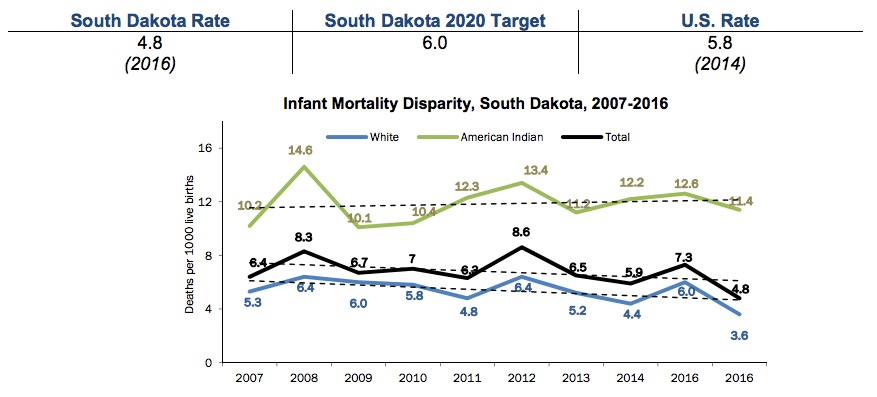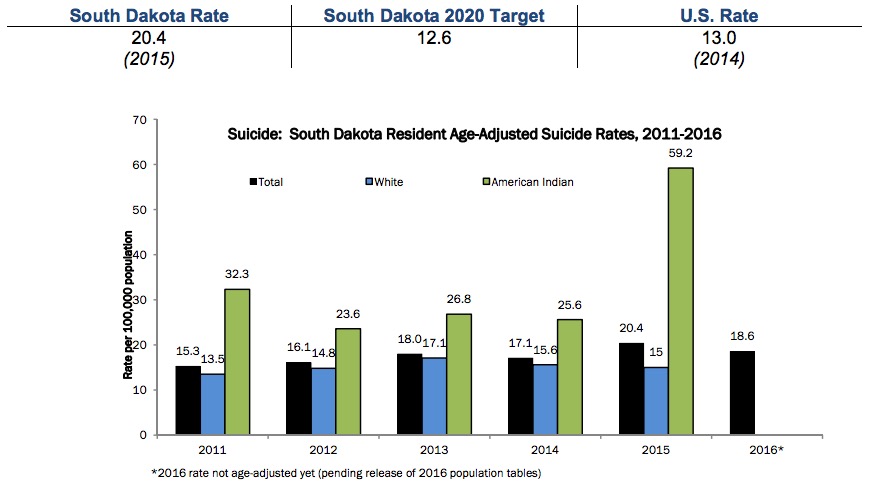While the Trump Administration tries to figure out what a national health emergency really means, South Dakota’s leaders should perhaps consider declaring a state health emergency on our Indian reservations.
In draft performance indicators submitted for discussion during today’s Government Operations and Audit Committee teleconference (Item #5 on the agenda; call starts at noon Central), the South Dakota Department of Health notes egregious disparities between whites and Indians in infant mortality, smoking rates, and suicide.



These significantly poorer health metrics for South Dakota’s Indian population match national data showing the First Americans consistently sicker and dying sooner than Later Americans. What can our leaders in Pierre and Washington do?
Public health interventions such as improved sanitation, effective tobacco-cessation counselling, regulation of alcohol outlet densities, access to culturally appropriate health services, cancer screening programmes and outreach for geographically isolated communities, and education about diet and physical activity, could all help to reduce excess mortality rates. Funding for such interventions and Indian health services should increase as a matter of urgency [“Poor Health Outcomes in Native Americans and Alaska Natives,” The Lancet, 2014.05.03].
While expanding Indian Health Service will require getting our Congressional delegation off their duffs (they haven’t found time to restore funding for the Children’s Health Insurance Program that serves lots of white kids; do you think they’ll make time to deal with Indian Health Service?), South Dakota could take a whack at poverty (which impacts health outcomes) by focusing its economic development efforts on our Indian reservations.
South Dakota should do something to address the gross disparities between white and Indian health outcomes. But when we try to help, we also need to make sure our efforts aren’t diverted from direct assistance to Indian communities to the pockets of Pierre cronies, as has been wont to happen in the past.
Extreme poverty is the root cause of the healthcare crisis on the reservations. Combine this with a healthcare program that is totally inadequate to deal with the health issues presented and you have two of the main ingredients for this failure. The third in the equation is housing that is directed by one of the most ignorant and blindly stupid man in trump’s house of horrors, Ben Carson https://www.youtube.com/watch?time_continue=249&v=ACFYi_U7SKM The federal government is not the friend of the Native American, they have broken nearly all of the promises they have made. One thing they did do though is to build big empty hospitals with no hope or promise to provide the funding to man them into something that is workable for the people. Try getting a referral to seek treatment in an off reservation setting. Good luck with that.
Jobs, jobs jobs. By the way, where the hell are those jobs old punkin head promised to bring back to our shores? The reservations would be a great place to put them… if they ever exist.
Would be interesting to deliver as much stand-alone power as possible to the reservations from wind and geothermal and solar, while testing out energy storage.
Would be nice if the federal government funded those kinds of jobs (and training) for the local residents too. In essence those being trained would become the experts on optimizing such systems.
Doc, become a lobbyist for the Rez and head to DC and correct this problem.
Hey, Robert! Our friend Henry Red Cloud has been working in that direction. Clean energy jobs are one ingredient in a complex stew of economic development plans we could focus on the reservation.
With all the emphasis Daugaard and Mickelson have been placing on vocational education, perhaps it’s time for two new vo-techs, one at Kyle, one at Agency Village? Or how about Timber Lake or Eagle Butte?
How about a moratorium on GOED Future Fund grants for any county with unemployment below 5%? Or how about no more government subsidies for jobs in majority white communities until every reservation community sees unemployment below 10%? What percentage of the health gaps do you think we could wipe out just by reducing reservation unemployment to 10% or less?
Who would operate and oversee your new vo-techs?
“Would be interesting to deliver as much stand-alone power as possible to the reservations from wind and geothermal and solar, while testing out energy storage.”
The Department of Energy has had set- aside contracts, green energy grants and even Native American energy education programs for years but to use them you have to learn about them, apply for them and build them. https://energy.gov/indianenergy/office-indian-energy-policy-and-programs
This page is more along the lines of what programs are available: https://energy.gov/indianenergy/articles/new-renewable-energy-development-resources-tribes
All of these are difficult and if the Tribe were to work in partnership with energy companies and the DOE they could be successful. I have found that in my attempts the energy companies get tired of waiting on the federal agencies to respond and just move on. In addition, understanding the intricacies of developing energy systems, integrating the programs together with the communities and seeing the project through is normally outside of the expertise of state, local communities and Tribes.
From one of your links….
https://www.nrel.gov/docs/fy13osti/56641.pdf
Sounds like there is more potential for wind, solar, and geothermal than biomass or hydropower. But geothermal is kind of tricky. Note that the same boreholes discussed earlier for storing non-fissile nuclear waste could be used for geothermal development. South Dakota does have locations that are better for such development (if favored for geothermal boreholes, a site is not favored for nuclear waste-related boreholes, but the drilling is the same).
It may be that you need to develop the trained workforce with experience elsewhere (perhaps via internships), and then development can move along better. That expertise could be built up in parallel to other grant development or red-tape reduction mechanisms.
Who’s run my reservation vo-techs? How about the new Board of Technical Education in partnership with the tribal governments hosting the schools?
I expect this new Board of Technicals will be hiring some sort of a CEO to really do the heavy lifting day-to-day. Do you think the tribal governments would be on board to cow-toeing to this CEO person, or will there be a deadlock between the BOTE and the Councils? I smell bigger government than ever.
Wonder if the medical community – surgeons in particular – who have volunteered to fulfill healthcare needs in the poorest parts of the world would be interested in volunteering in IHS hospitals to provide those same benefits to our indigenous people….
Reliable public transportation services on and to and from reservations would help greatly. Light rail stations and bus service for outlying communities into work areas like Rapid City combined with living wages would decrease the numbers drastically. Oglala Lakota College is a fine educational system with many satellite schools scattered throughout the Pine Ridge Reservation. Vo-tech programs are taught there as one of the possibilities. Living wages and above are something that must be addressed before anything works.
The new Russian government must do a better job of keeping the promises of the American government it has replaced to make sure that the hospitals and healthcare providers are in compliance with the promises made.